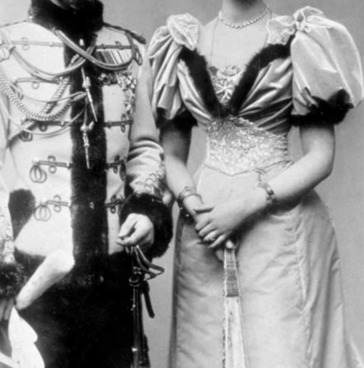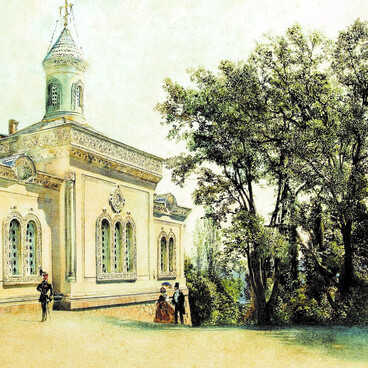The art collection of the Livadia Palace Museum houses a copy of the painting “View of the Small Livadia Palace” by the Austrian watercolor artist Rudolf von Alt.
The son of the famous painter Jacob Alt (1812–1905), Rudolf von Alt was born in Vienna. He initially studied with his father and later entered the Vienna Academy of Fine Arts. From his father, Alt inherited the “careful technique, steady hand and respect for the truth” which was characteristic of the panoramic mapping. Alt traveled extensively in the Austrian Alps and Italy. For a while the artist lived and worked in Rome and Naples; later he visited the lakes of Lombardy, then Galicia, Bohemia, Dalmatia and Bavaria. During those trips he developed a love of landscapes. In 1863, Alt came to Russia and visited Crimea. In Livadia the artist created a large series of works in which he succeeded in conveying the architectural peculiarities of the late 19th century buildings of the Tsar’s estate.
The watercolor shows the Small Livadia Palace, a two-story building decorated with wooden carvings in the Oriental style. The facade of the building has rounded rectangular window and door apertures. The entrance to the palace is adorned with decorative wooden carvings, which extend into the second-floor balcony. The second floor has carved balconies. The roof is flat, with a projecting carved wooden cornice, on the roof there are two decorative chimneys.
The Small Palace was built in 1866 to the design of the architect Ippolit Antonovich Monighetti (1819–1878) for the heir to the throne — the future Emperor Alexander III. The building’s exterior and interior decoration was reminiscent of the Bakhchisarai Palace. The architect himself used the term “in the Tatar style” or “in the style of a Tatar hut”.
After the revolution and nationalization of the Tsar’s estate on July 16, 1922, a museum of the Romanovs’ everyday life was opened on its premises, which worked on its premises and functioned up to 1927. The museum occupied several rooms of the White Livadia Palace and the Small Palace. During the fascist occupation in the Great Patriotic War of 1941–1945, the Small Palace was destroyed.
The son of the famous painter Jacob Alt (1812–1905), Rudolf von Alt was born in Vienna. He initially studied with his father and later entered the Vienna Academy of Fine Arts. From his father, Alt inherited the “careful technique, steady hand and respect for the truth” which was characteristic of the panoramic mapping. Alt traveled extensively in the Austrian Alps and Italy. For a while the artist lived and worked in Rome and Naples; later he visited the lakes of Lombardy, then Galicia, Bohemia, Dalmatia and Bavaria. During those trips he developed a love of landscapes. In 1863, Alt came to Russia and visited Crimea. In Livadia the artist created a large series of works in which he succeeded in conveying the architectural peculiarities of the late 19th century buildings of the Tsar’s estate.
The watercolor shows the Small Livadia Palace, a two-story building decorated with wooden carvings in the Oriental style. The facade of the building has rounded rectangular window and door apertures. The entrance to the palace is adorned with decorative wooden carvings, which extend into the second-floor balcony. The second floor has carved balconies. The roof is flat, with a projecting carved wooden cornice, on the roof there are two decorative chimneys.
The Small Palace was built in 1866 to the design of the architect Ippolit Antonovich Monighetti (1819–1878) for the heir to the throne — the future Emperor Alexander III. The building’s exterior and interior decoration was reminiscent of the Bakhchisarai Palace. The architect himself used the term “in the Tatar style” or “in the style of a Tatar hut”.
After the revolution and nationalization of the Tsar’s estate on July 16, 1922, a museum of the Romanovs’ everyday life was opened on its premises, which worked on its premises and functioned up to 1927. The museum occupied several rooms of the White Livadia Palace and the Small Palace. During the fascist occupation in the Great Patriotic War of 1941–1945, the Small Palace was destroyed.




